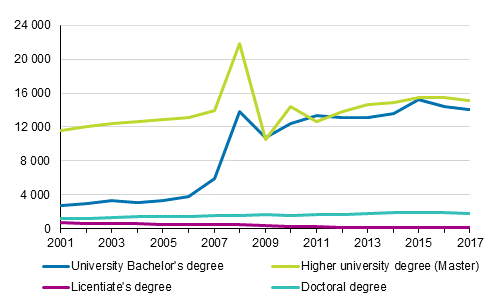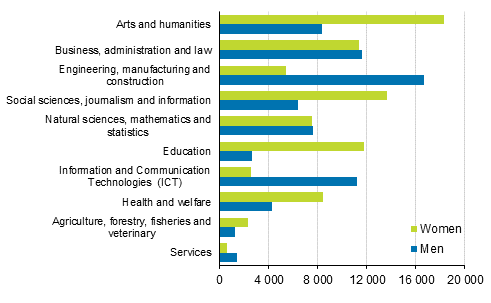This set of statistics has been discontinued.
Statistical data on this topic are published in connection with another set of statistics.
Data published after 5 April 2022 can be found on the renewed website.
Published: 8 May 2018
Number of doctorate degrees fell by 7 per cent from the previous year
According to Statistics Finland's Education Statistics, 31,000 university degrees were completed in 2017, which is almost 900 fewer than in the previous year. The number of doctorate degrees fell proportionally most, by seven per cent compared with the previous year. The number of lower university degrees decreased by three per cent and that of higher university degrees by two per cent from the year before.
Completed university degrees 2001–2017

University degrees
In all, 14,000 lower university degrees, 15,100 higher university degrees, 100 licentiate degrees and 1,750 doctorate degrees were completed. Fifty-eight per cent of those having completed a degree in 2017 were women. Nearly seven per cent of the degrees were attained by foreign students, the figure being almost 11 per cent for higher university degrees and 23 per cent for doctorate degrees.
According to the national classification of education (2016), most degrees in 2017 were completed in the field of business, administration and law, 18 per cent of all degrees. Sixteen per cent of degrees were completed in arts and humanities and around 14 per cent of degrees were completed in both social sciences, journalism and information and engineering, manufacturing and construction. Most doctorate degrees were completed in the fields of health and welfare, and engineering, manufacturing and construction, in both around one-fifth of all completed doctorate degrees.
Examined by university, the highest numbers of degrees were completed at the University of Helsinki, good 6,000. The second most degrees were completed at the University of Turku, nearly 3,500 and the third most at Aalto University, 3,400.
University students
In 2017, a total of 24,900 new students started studies, which is 700 fewer than one year previously. The number of new students studying for higher university degrees decreased by 10 per cent. By contrast, the number of new students studying for lower university degrees went down by only one per cent and the number of new doctoral programme students, in turn, grew by 11 per cent compared with the year before. In all, 16,400 students started studying for a lower university degree and close on 6,600 for a higher university degree. Nearly 1,900 students started studies for a doctorate degree.
University students by fields of education (Finnish Standard Classification of Education) and gender in 2017

In 2017, a total of 153,300 students were studying at universities, which is one per cent lower than in the previous year. In all, 78,300 students were studying for a lower university degree and 56,200 for a higher university degree. There were 18,600 post-graduate students, of whom good 900 were studying for a licentiate degree and around 17,700 for a doctorate degree.
In 2017, the highest numbers of students were studying in the field of arts and humanities, 17 per cent. The second most students were studying in the field of business, administration and law, 15 per cent. Fourteen per cent of students were studying in the field of engineering, manufacturing and construction and 13 per cent in social sciences, journalism and information. The proportion of women of all students attending education leading to a degree was 53 per cent but the variation was large between fields of education. Good four out of five students in education were women, while in the field of information and communication technology (ICT), the proportion of women was nearly one-fifth of students. In arts and humanities and social sciences, journalism and information, women made up good two-thirds of students. Health and welfare, and agriculture and forestry were also female-dominated: around two-thirds of students were women. In contrast, both sexes represented around one-half of students in business, administration and law, and natural sciences.
The number of students was highest at the University of Helsinki, 31,300. The second most students were found at Aalto University, good 17,300, and the third most at the University of Turku, about 16,200. More detailed time series data on university students and degrees by education and university are available in the tables in databases .
Source: Education. Statistics Finland
Inquiries: Jukka Jalolahti 029 551 3588, koulutustilastot@stat.fi
Director in charge: Jari Tarkoma
Publication in pdf-format (281.8 kB)
- Tables
-
Tables in databases
Pick the data you need into tables, view the data as graphs, or download the data for your use.
Appendix tables
- Appendix table 1. Students in universities and completed university degrees by level of education, fields of education (National classification of education 2016) and gender in 2017 (8.5.2018)
- Appendix table 2. Foreign students in universities and completed university degrees by level of education, fields of education (National classification of education 2016) and gender in 2017 1) (8.5.2018)
Updated 8.5.2018
Official Statistics of Finland (OSF):
University education [e-publication].
ISSN=2324-0148. 2017. Helsinki: Statistics Finland [referred: 23.12.2025].
Access method: http://stat.fi/til/yop/2017/yop_2017_2018-05-08_tie_001_en.html

